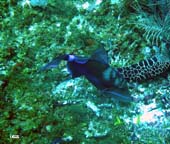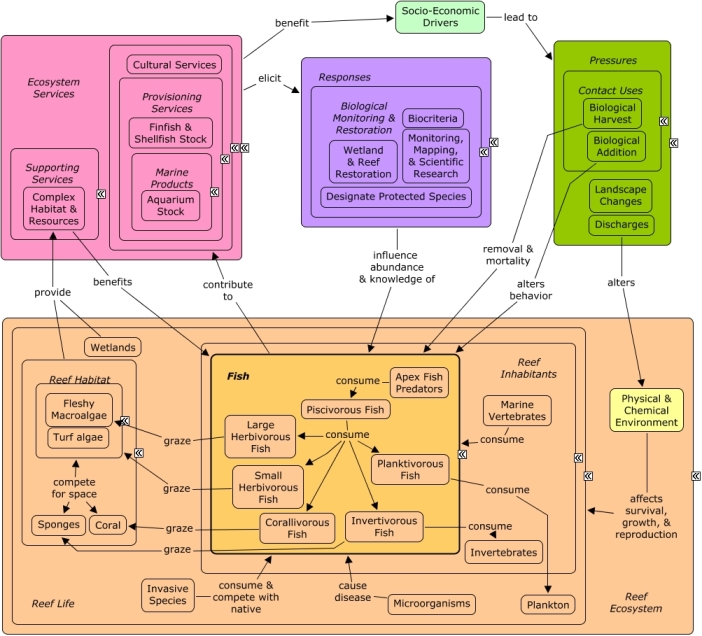ReefLink Database

Large Herbivorous Fish
Large herbivorous fish are any large bodied fish that primarily feed on algae, such as parrotfish and chubs.
CMap

CMap Description
The fish found on coral reefs are essential for coastal communities and extremely important in the wider world. Large herbivorous fish, such as many species of parrotfish, graze macroalgae and render a critical supporting service in maintaining the reef habitat. In turn, the reef life provides the supporting service of complex habitat & resources for the benefit of all fish. Also, a few large herbivorous fish species are important as aquarium stock. Many large herbivorous fish species contribute to the provisioning service, and all species are important to the cultural services of coral reefs. Wetlands provide nursery habitat that supports the fish community. Large herbivorous fish are consumed by piscivorous fish, apex fish predators, and marine mammals and reptiles. In addition, large herbivorous fish are stressed or killed by competing invasive species, disease- causing microorganisms, and a disturbed physical & chemical environment. Socio-economic drivers lead to the removal & mortality through fishing pressures and behavior modifications through supplemental feeding. Biological monitoring, mapping, research, and restoration is paramount to ensure the flow of services from reef fish.Citations
More than 50 citations. Click here to load.
| Citation | Year | Study Location | Study Type | Database Topics |
|---|
Management Options
| Management Option | Description | Sources | Database Topics |
|---|---|---|---|
| Economic Markets & Policy: Create Alternative Livelihoods For Fishermen | Many fishermen rely on their catch as their family�s main source of income. When restrictions are placed on fishing it can be to the economic detriment of these fishermen. By creating alternative means of earning income for these fishermen, social and economic goals are accomplished while decreasing pressures on natural fish populations. These alternatives often come in the form of aquaculture, which helps to still meet the demand for fish. Another common alternative is tourism; fishermen can use their knowledge and equipment such as boats to accommodate tourism and recreational fishing. | All Islands Coral Reef Committee. Local Action Strategies. United States Coral Reef Task Force Accessed 6/13/2011. Sumaila, U.R., William W. L. Cheung and Louise The. 2007. Rebuilding Hong Kong's marine fisheries: an evaluation of management options. FCRR 2007, Vol. 15(3), Fisheries Centre, The University of British Columbia, Vancouver, BC. |
Agriculture, Aquaculture, & Forestry Policies; Apex Fish Predators; Aquaculture; Artisanal Fishing; Biological Harvest; Collaboration & Partnering; Commercial Fisheries; Cultural Policies; Culture; Fish; Fisheries & Hunting Policies; Fishing & Harvesting Management; Fishing Sector; Food & Raw Materials; Health; Invertebrates; Large Herbivorous Fish; Social Assistance; Tourism & Recreation |
| Fishing & Harvesting Management: Derelict Fishing Gear & Ghost Fishing | The term "ghost fishing" is used to describe the capture of marine organisms by lost or abandoned fishing gear. This is particularly a problem with gillnets, trammel nets and pots. Gear is usually lost because it becomes stuck on rough bottoms containing corals and stones, causing the buoy line to break during retrieval. Nets or pots may continue to fish for years, with captured fish and crustaceans dying and serving as attracting bait for more fish and organisms. Ghost fishing may therefore represent a serious problem in many areas, causing hidden fishing mortality over a long period of time. This management option co-insides with (#63) Respond to Natural Resource Injuries form Derelict Vessels. | Cochrane, K.L., editor. 2002. A Fishery Manager's Guidebook. Management Measures and their application. Fisheries Technical Paper 424, FAO, Rome. Seas At Risk. 2009. Moving Towards Low Impact Fisheries In Europe Policy Hurdles & Actions. |
Accidental & Illegal Harvest; Apex Fish Predators; Aquaculture; Arthropods; Artificial Habitat; Artisanal Fishing; Biological Addition; Biological Harvest; Commercial Fisheries; Corallivorous Fish; Discharges; Finfish & Shellfish Stock; Fish; Fishing & Harvesting Management; Fishing Sector; Invertivorous Fish; Large Herbivorous Fish; Littering; Lobster, Crab, & Shrimp; Marine Debris; Piscivorous Fish; Planktivorous Fish; Provisioning Services; Recreational Fishing; Trawling & Fishing Gear Damage |
| Monitor & Research: Fisheries Sampling | Improved fisheries sampling programs require improving the spatial resolution of commercial and recreation fisheries-dependent and fisheries-independent sampling programs to provide statistics on catch and effort. Improved sampling can be achieved through evaluating and enhancing census programs by using smaller sampling areas. Also, fishery pre-recruitment monitoring efforts should be continued for long-term prediction of fishery stocks. Last, investigating life histories of fishery species needs to be conducted because it is currently a gap. | NOAA Marine Sanctuary Program. 2007. Florida Keys National Marine Sanctuary revised management plan. National Ocean Service, Key West, FL. |
Apex Fish Predators; Biological Harvest; Biological Monitoring & Restoration; Biological Monitoring, Mapping, & Scientific Research; Corallivorous Fish; Decision Support; Ecosystem Monitoring & Restoration; Finfish & Shellfish Stock; Fish; Fishing & Harvesting Management; Fishing Sector; Invertivorous Fish; Large Herbivorous Fish; Piscivorous Fish; Planktivorous Fish; Provisioning Services; Reef Inhabitants; Reef Life; Security & Public Administration Policies; Small Herbivorous Fish |
| Monitor & Research: Biological Status and Trends Monitoring | This activity produces long-term comprehensive information on sanctuary-wide status and trends of biological resources. Data that could be collected on coral reef communities includes but is not limited to species abundance and density, biodiversity, benthic cover, coral condition, growth, recruitment, predation, and grazing. Mangroves and seagrasses should also be monitored. With adequate baseline data, changes in community structure and biocriteria can be identified and restoration or protection efforts can be taken. | NOAA Marine Sanctuary Program. 2007. Florida Keys National Marine Sanctuary revised management plan. National Ocean Service, Key West, FL. |
Algae; Anemones & Zooanthids; Apex Fish Predators; Aquaculture; Aquarium Stock; Biochemical & Genetic Resources; Biocriteria; Biological Harvest; Biological Monitoring & Restoration; Biological Monitoring, Mapping, & Scientific Research; Bivalves; Calcareous Macroalgae; Contact Uses; Coral; Coralline Algae; Cyanobacteria; Decision Support; Echinoderms; Ecosystem Monitoring & Restoration; Finfish & Shellfish Stock; Fish; Fishing Sector; Food & Energy Policies; Hydrocoral; Invasive Species; Invertebrates; Large Herbivorous Fish; Lobster, Crab, & Shrimp; Mangroves; Marine Birds; Marine Products; Marine Vertebrates; Marine Worms; Microorganisms; Molluscs; Octocoral; Octopus & Squid; Ornamental Jewelry & Art; Pathogens; Pharmaceuticals & Cosmetics Sources; Physical Damage; Primary Production; Provisioning Services; Resource Use Management; Sea Turtles; Sea Urchins; Seagrasses; Seastars; Skeletal Coral; Small Herbivorous Fish; Snails & Conch; Sponges; Stony Coral; Tunicates; Wetlands; Whales & Dolphins |
| Public Participation: Assist Seafood Watch | Assist Seafood Watch and other sustainable seafood consumption initiatives, in their efforts to educate the public and promote sustainable seafood. | The Coral Reef Alliance (CORAL) the Tour Opperators' Iniative (TOI) and The Center for Environmental Leadership in Business (CELB). 2003. A Practical Guide to Good Practice: Managing Environmental Impacts In The Marine Recreation Sector. SeafoodWatch. 2005. Sustainable Seafood Business Practices. Monteray Bay. |
Accidental & Illegal Harvest; Apex Fish Predators; Aquaculture; Artisanal Fishing; Biological Harvest; Collaboration & Partnering; Commercial Fisheries; Corallivorous Fish; Environmental Education & Outreach; Finfish & Shellfish Stock; Finfish Harvest; Fish; Fisheries & Hunting Policies; Fishing & Harvesting Management; Fishing Sector; Food & Energy Policies; Food & Raw Materials; Invertebrate Harvest; Large Herbivorous Fish; Live Collection; Lobster, Crab, & Shrimp; Molluscs; Provisioning Services; Recreational Fishing; Sectors Filling Human Needs |
| Resource Use Management: Seasonal Fisheries and Harvesting | Finfish and shellfish stocks may be more or less susceptible to fishing pressures during certain times of the year. This may be due to seasonality of recruitment and/or changes in food/predation pressures. If fishing restrictions may be more successful if this seasonality is taken into consideration and fishing pressure adjusted accordingly. | Accidental & Illegal Harvest; Apex Fish Predators; Artisanal Fishing; Biochemical & Genetic Resources; Biological Harvest; Bivalves; Commercial Fisheries; Corallivorous Fish; Decision Support; Echinoderms; Finfish & Shellfish Stock; Finfish Harvest; Fish; Fisheries & Hunting Policies; Fishing & Harvesting Management; Fishing Sector; Food & Energy Policies; Invertebrate Harvest; Invertivorous Fish; Large Herbivorous Fish; Live Collection; Lobster, Crab, & Shrimp; Marine Products; Molluscs; Octopus & Squid; Permitting & Zoning; Piscivorous Fish; Planktivorous Fish; Provisioning Services; Recreational Fishing; Small Herbivorous Fish; Snails & Conch; Sponges; Tourism & Recreation Policies | |
| Resource Use Management: Fisheries Catch Quotas | Quotas designate the Total Allowable Catch (TAC) allocated to an operating unit such as a country, a vessel, a company or an individual fisherman (individual quota) depending on the system of allocation. Quotas may or may not be transferable, inheritable, and tradable. While generally used to allocate total allowable catch, quotas could be used also to allocate fishing effort or biomass. | Seas At Risk. 2009. Moving Towards Low Impact Fisheries In Europe Policy Hurdles & Actions. |
Accidental & Illegal Harvest; Anchoring & Vessel Grounding; Apex Fish Predators; Artisanal Fishing; Biological Harvest; Bivalves; Boat Movement; Boating Activities; Commercial Fisheries; Commercial Fishing Boats; Finfish & Shellfish Stock; Finfish Harvest; Fish; Fisheries & Hunting Policies; Fishing & Harvesting Management; Fishing Sector; Food & Raw Materials; Invertebrate Harvest; Invertivorous Fish; Large Herbivorous Fish; Live Collection; Lobster, Crab, & Shrimp; Marine Products; Molluscs; Octopus & Squid; Piscivorous Fish; Planktivorous Fish; Provisioning Services; Recreational Fishing; Snails & Conch; Trawling & Fishing Gear Damage |
| Restoration: Removal of Invasive Algae | Benthic organisms on reefs maintain a delicate balance competing for space. In many areas, the competition between coral and algae has fallen out of balance due to confounding factors. Factors such as decreased herbivorous fish and invertebrates, and invasive algae species have allowed faster growing algae to take over many reefs, often growing into smothering mats that cover and kill coral. In Hawaii, there has been some success physically removing invasive algae such as Kappaphycus using underwater vacuums extended down from barges or volunteer events in shallower areas. | The Nature Conservancy. 2010.Two Million Pounds of Invasive Algae Removed From Maunalua Bay. (not cited) |
Algae; Aquaculture; Biological Addition; Biological Harvest; Biological Monitoring & Restoration; Biological Monitoring, Mapping, & Scientific Research; Calcareous Macroalgae; Collaboration & Partnering; Coral; Coralline Algae; Decision Support; Ecosystem Monitoring & Restoration; Escape & Release of Non-natives; Fishing & Harvesting Management; Fishing Sector; Fleshy Macroalgae; Hydrocoral; Invasive Species; Large Herbivorous Fish; Octocoral; Reef Habitat; Skeletal Coral; Small Herbivorous Fish; Stony Coral; Turf Algae; Wetland & Reef Restoration; Zooxanthellae |
Laws
| Legal Citation | Purpose of Law | Management Organization | Database Topics |
|---|
